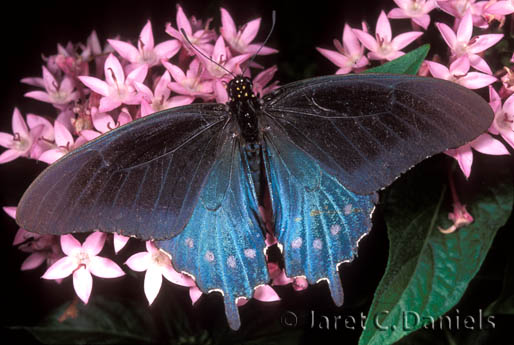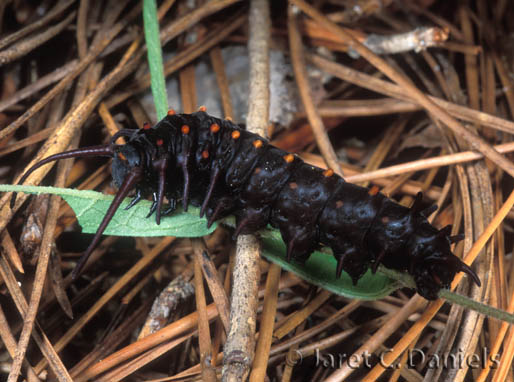- Family name: Papilionidae/Swallowtails
- General description: Male forewing velvety black; hindwing with single tail, iridescent blue-green scaling and single submarginal row of pale spots. Female duller black with more prominent pale spot band. Ventral hindwing black with iridescent blue-green scaling and single submarginal row of large orange spots.
- Field Marks: General: Single hindwing tail; ventral hindwing with single row of large orange spots; dorsal hindwing with single row of pale spots Male: Hindwing with iridescent blue-green scaling Female: Hindwing duller black with a submarginal row of pale spots
- Sexes: appear different
- Wingspan: 70-88 mm
- Life Cycle: Egg: orange-brown, spherical, laid singly or in small clusters on host leaves Mature Larva: black-brown with fleshy black or orange tubercles; longest pair near head Chrysalis: Brown to yellow-green
- Number of Generations: three or more
- Flight Season: February-November
- Abundance: Common
- Habitat: open woodlands, forest margins, old fields, pastures, gardens, roadsides
- Larval Host Plants: Virginia snakeroot (Aristolochia serpentaria)
- Similar Species: Red-spotted Purple
- Additional Information: Range is limited in Connecticut, Massachusetts, California, Nevada, Minnesota and South Dakota. Adults have very rapid flight and continuously flutter their wings when feeding. Larvae sequester chemicals from their host plants that render them and the resulting adults distasteful to avian predators. Adults serve as distasteful model to several other Florida butterflies including Eastern Black Swallowtail, Spicebush Swallowtail, and Eastern Tiger Swallowtail.
- Range in Florida
 The Florida Wildflowers & Butterflies projects at the Florida Museum are sponsored in part by the State of Florida and the Florida Wildflower Foundation, Inc.
The Florida Wildflowers & Butterflies projects at the Florida Museum are sponsored in part by the State of Florida and the Florida Wildflower Foundation, Inc.

